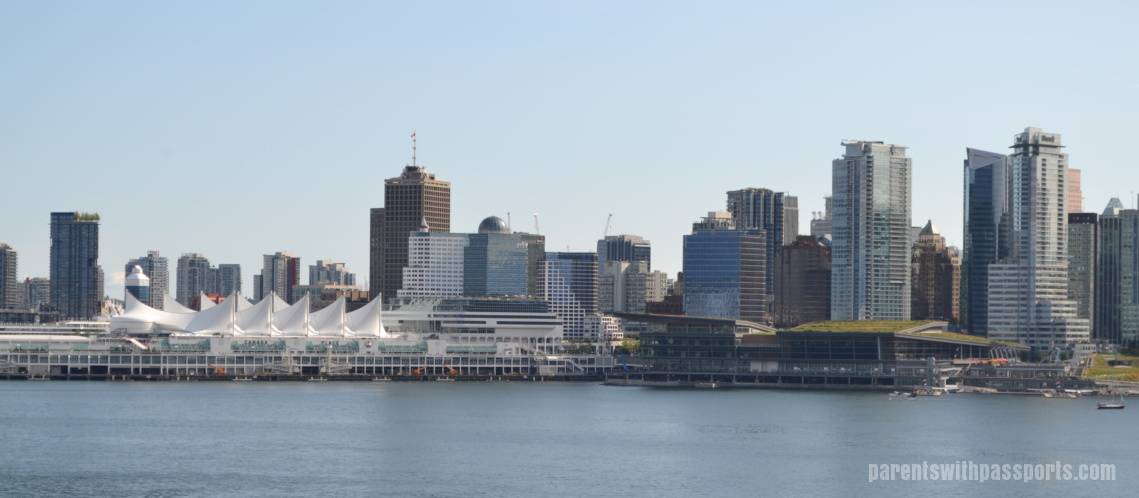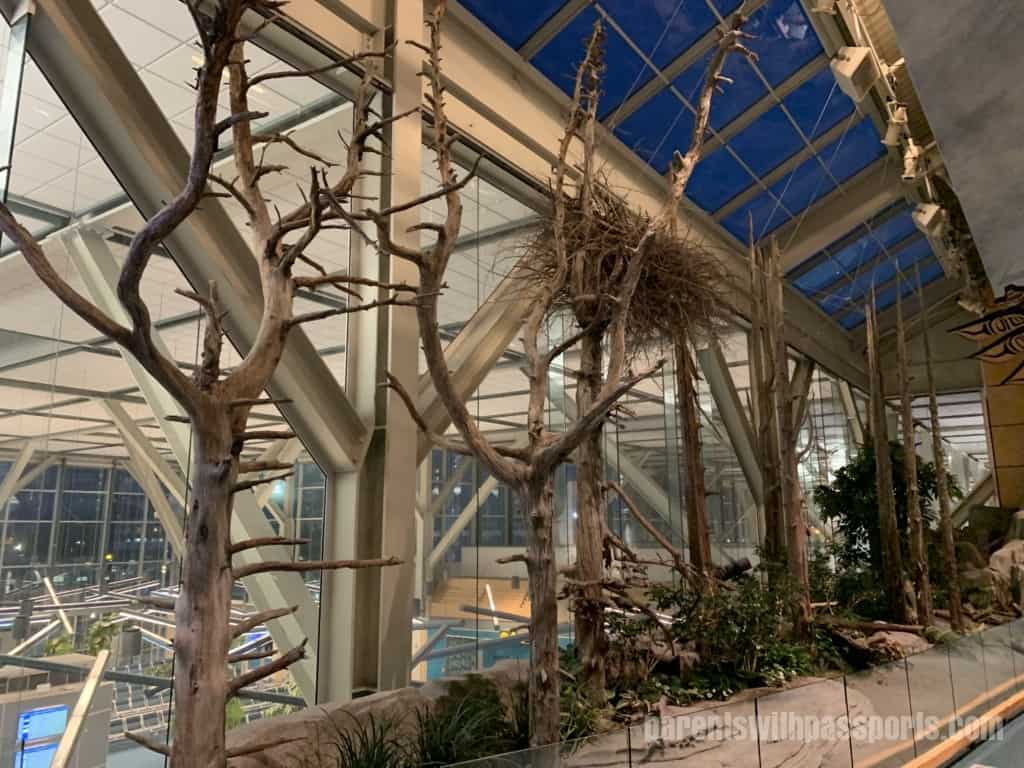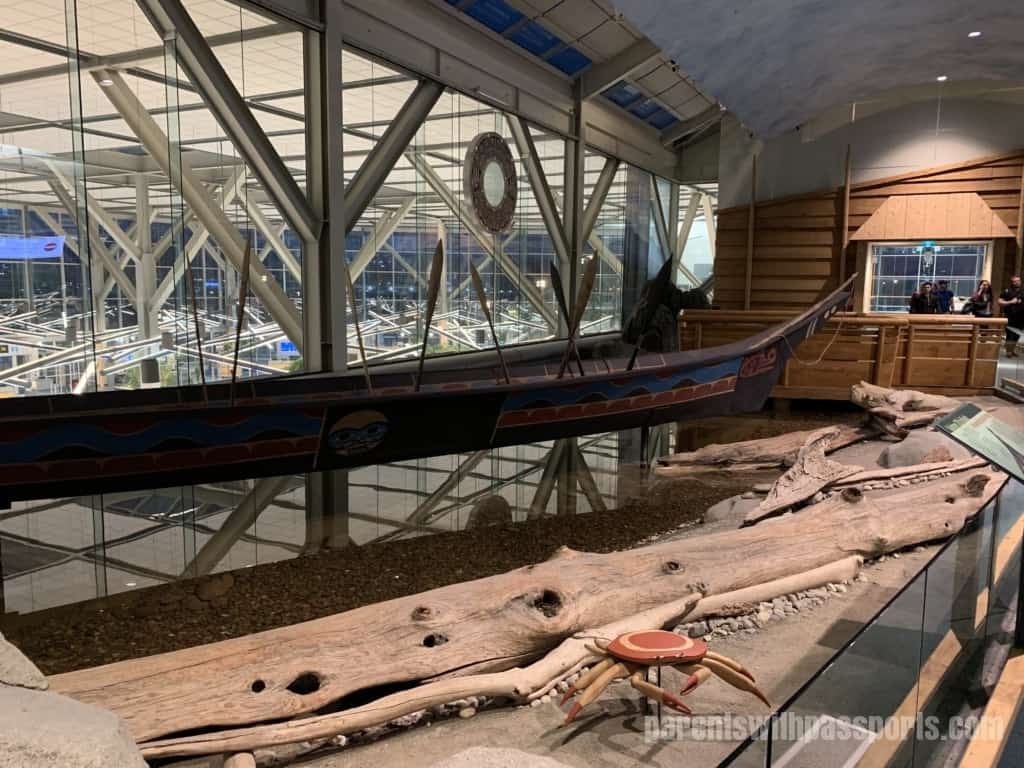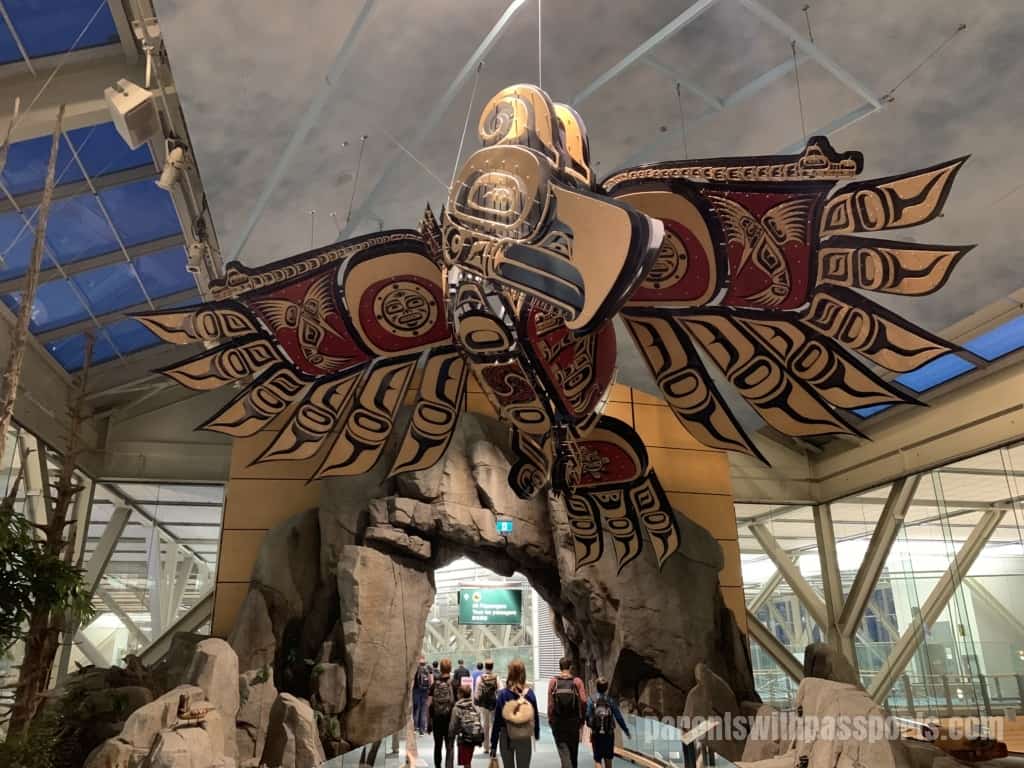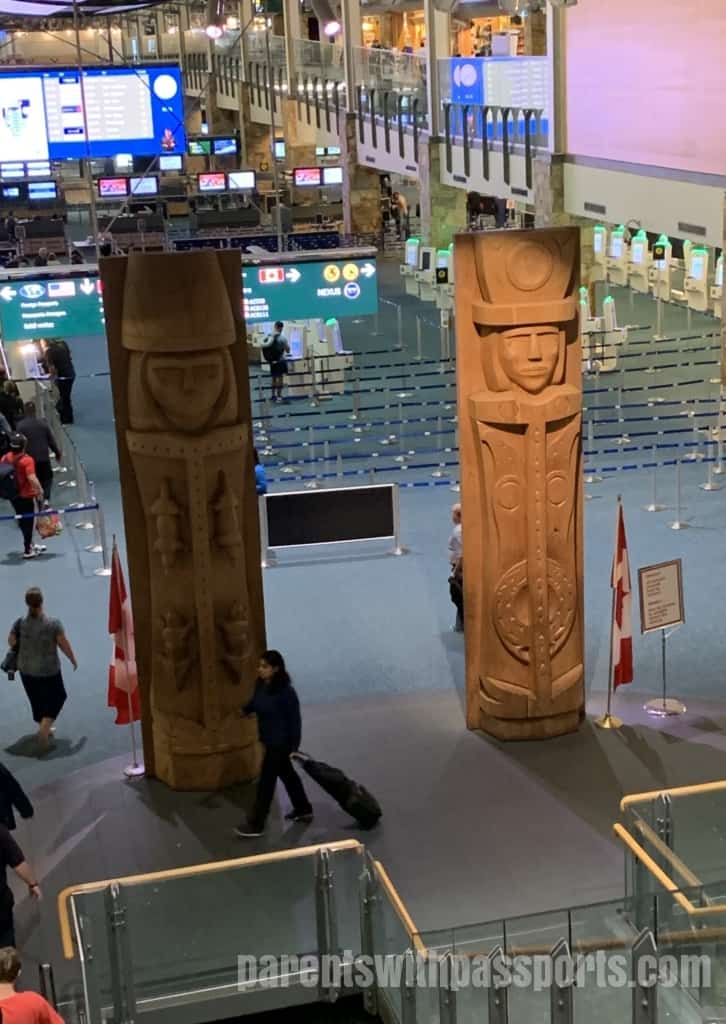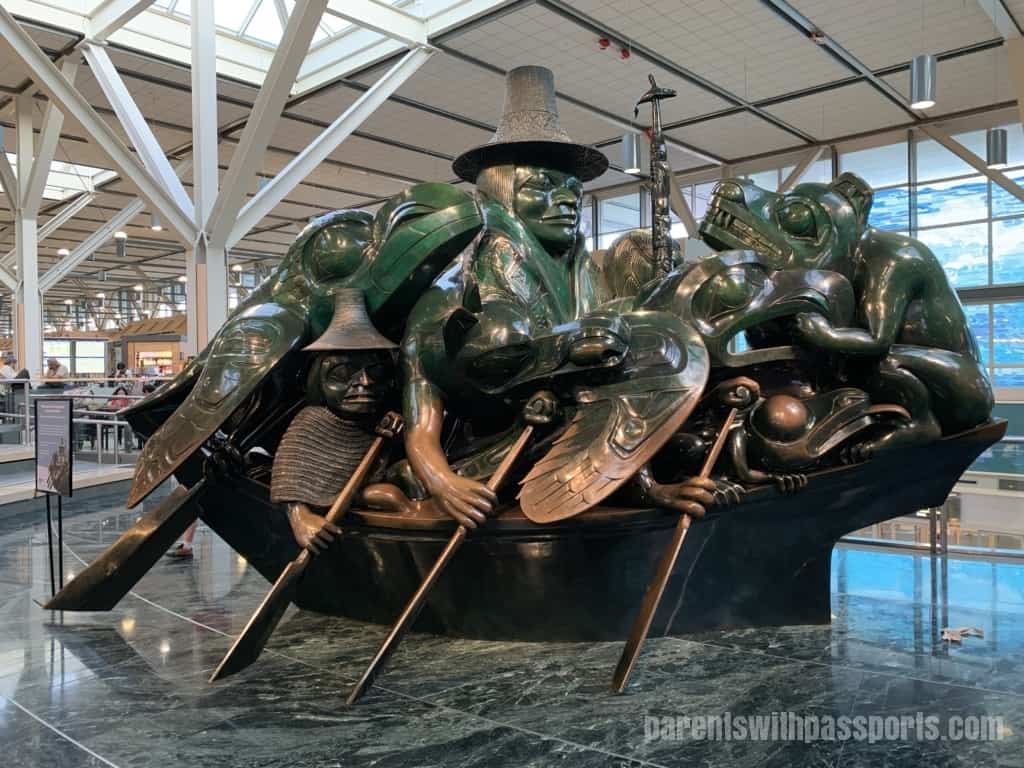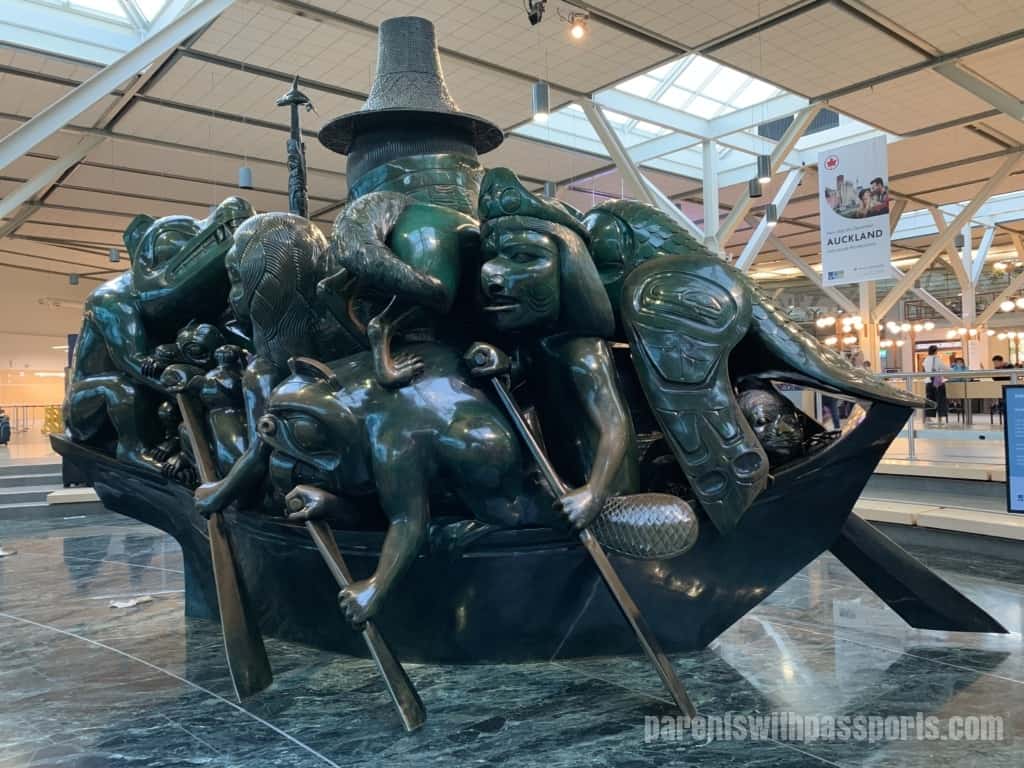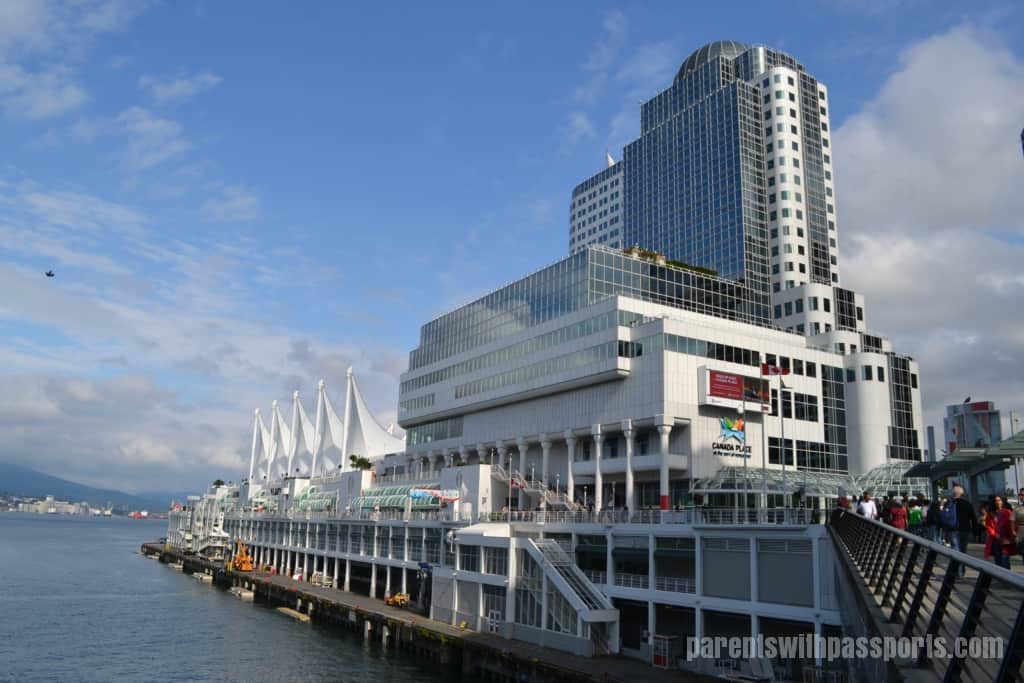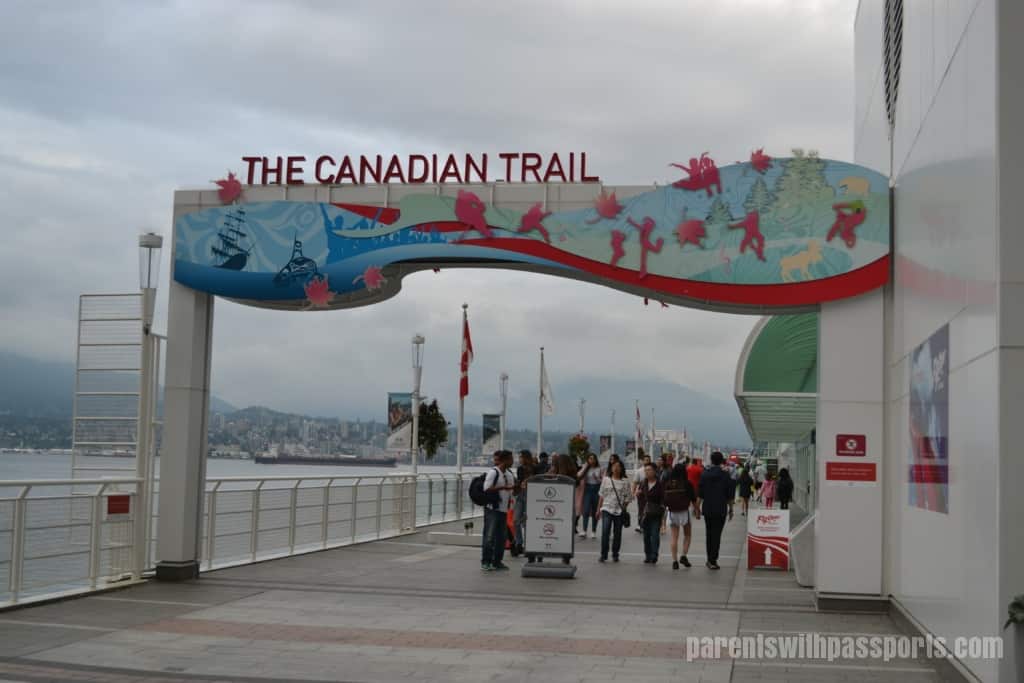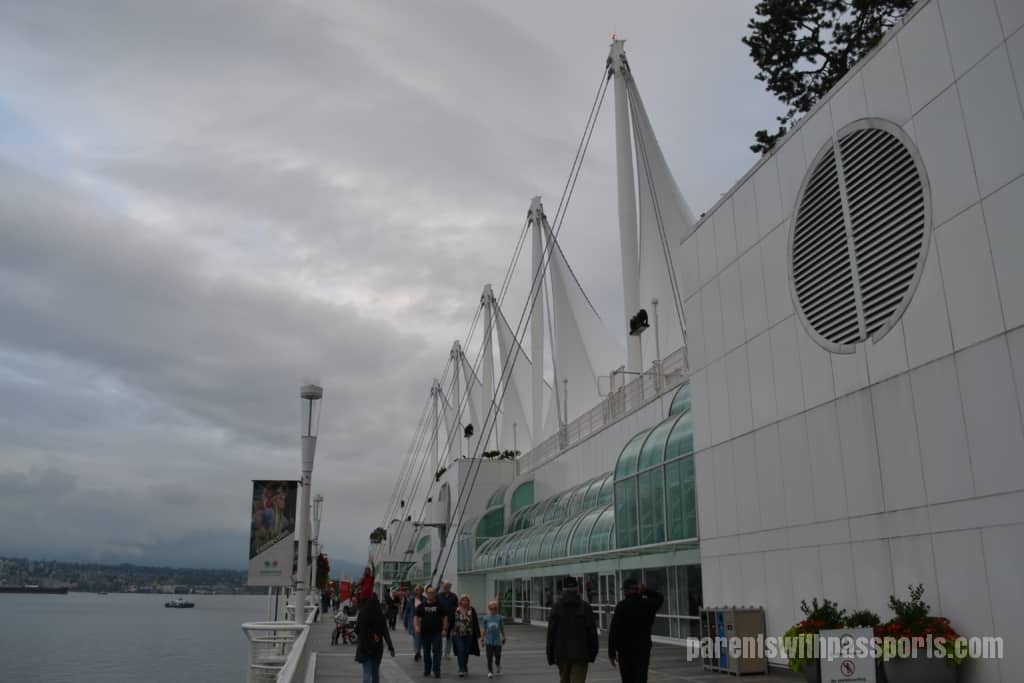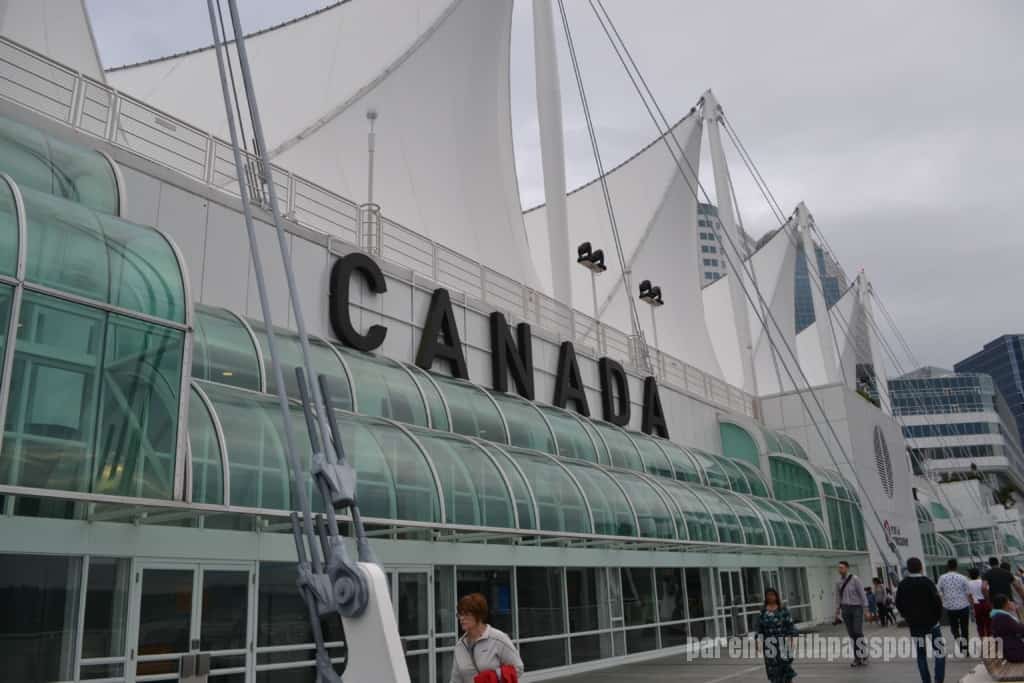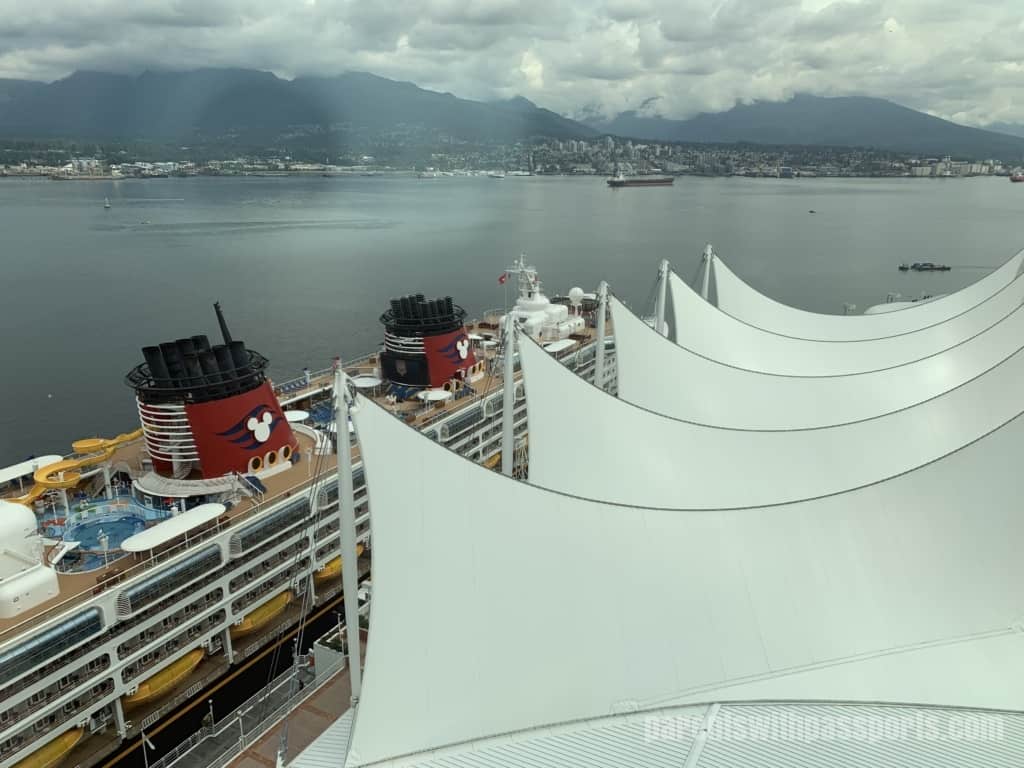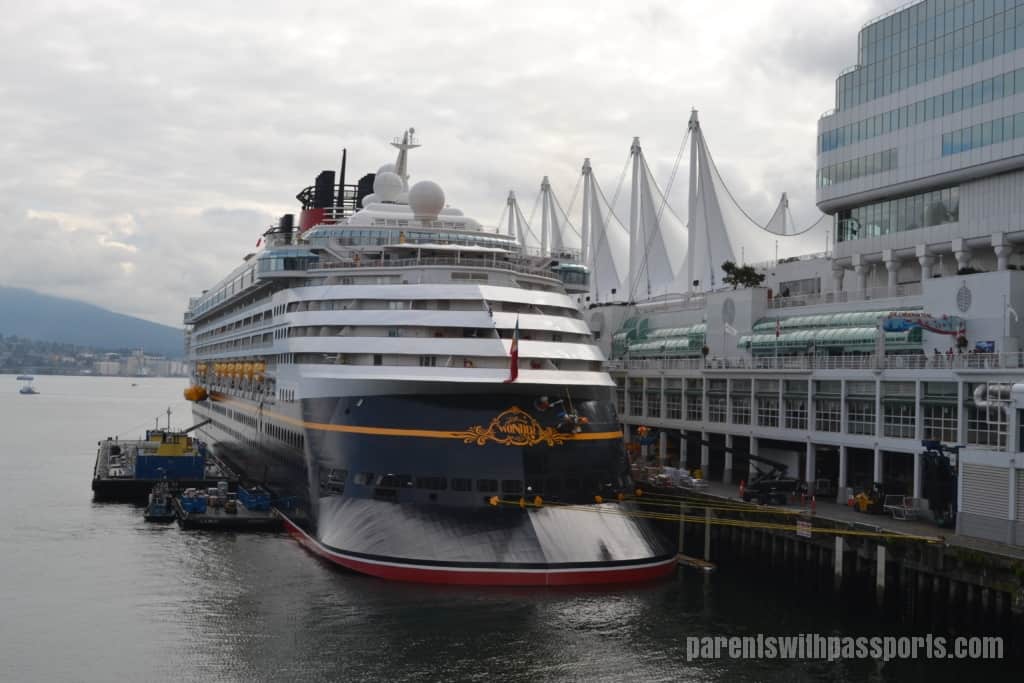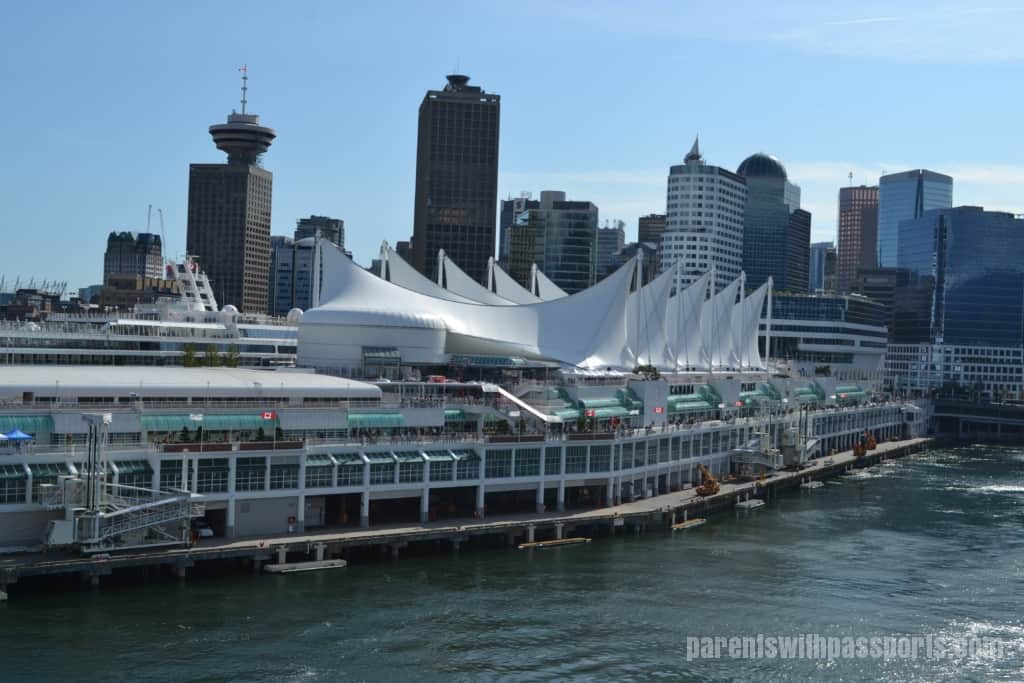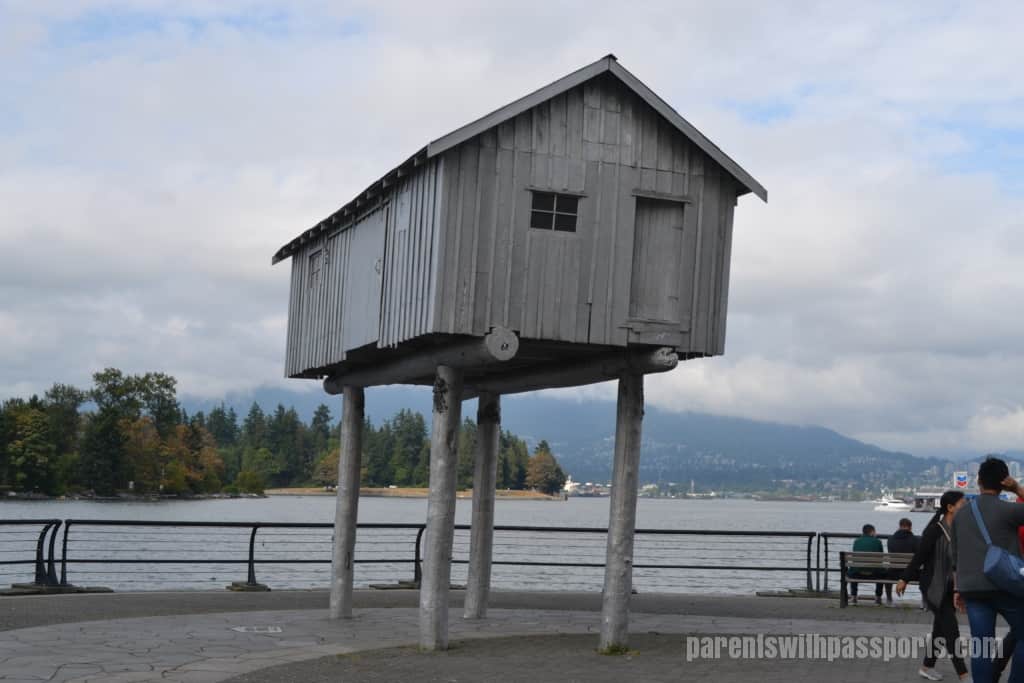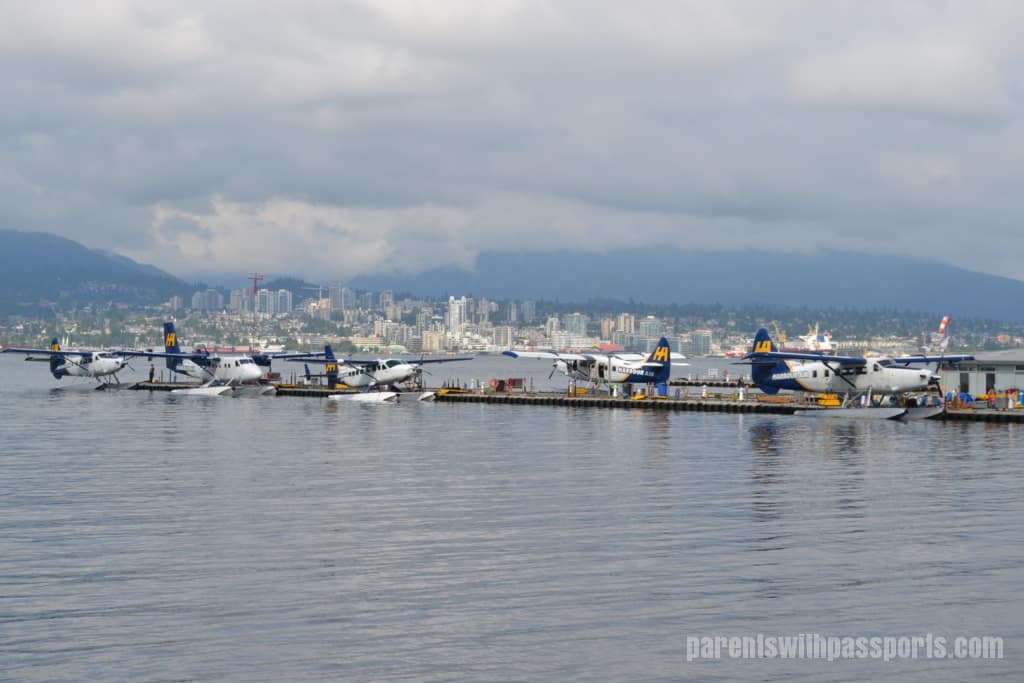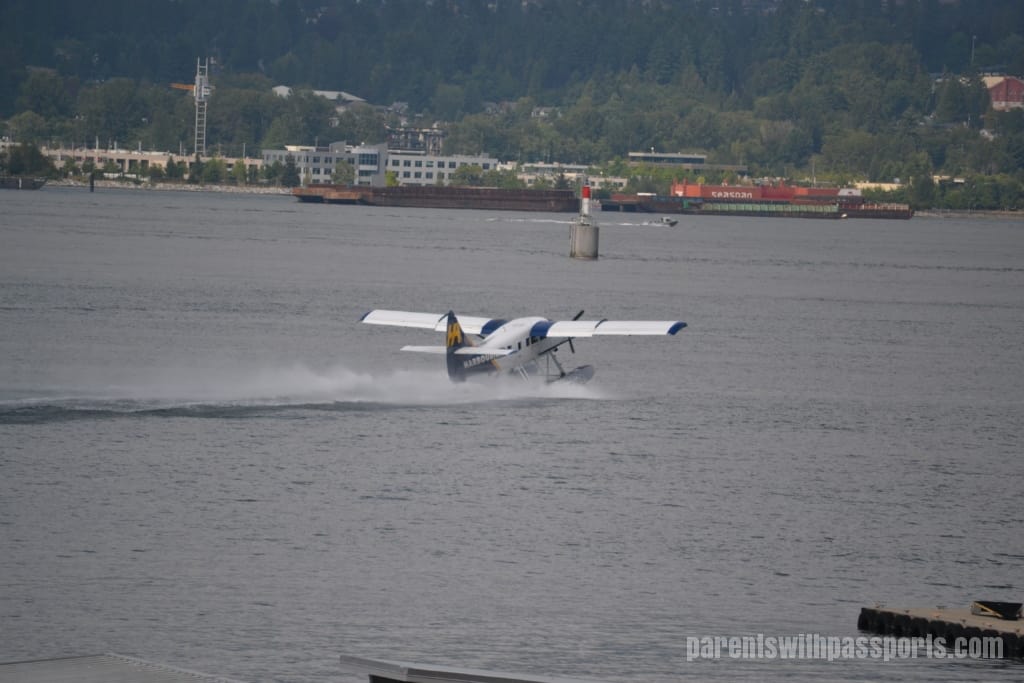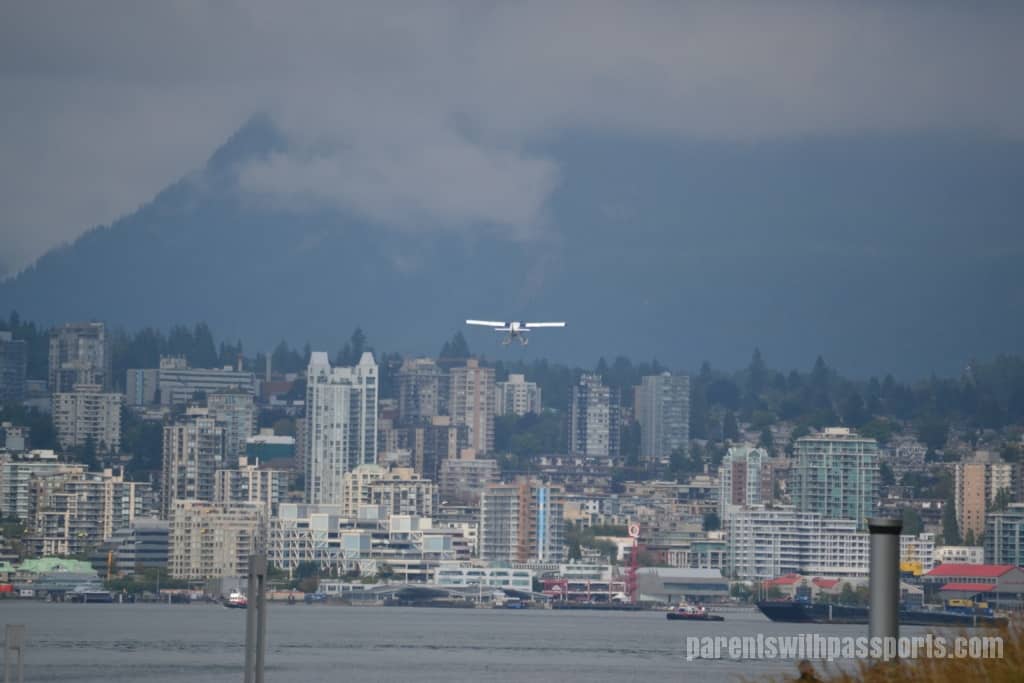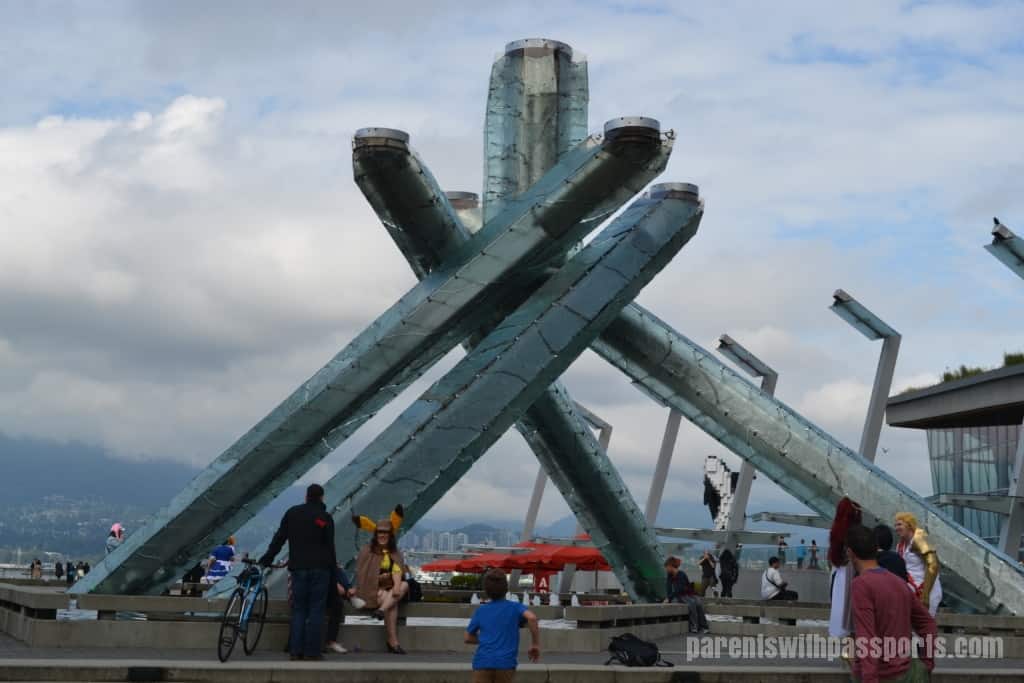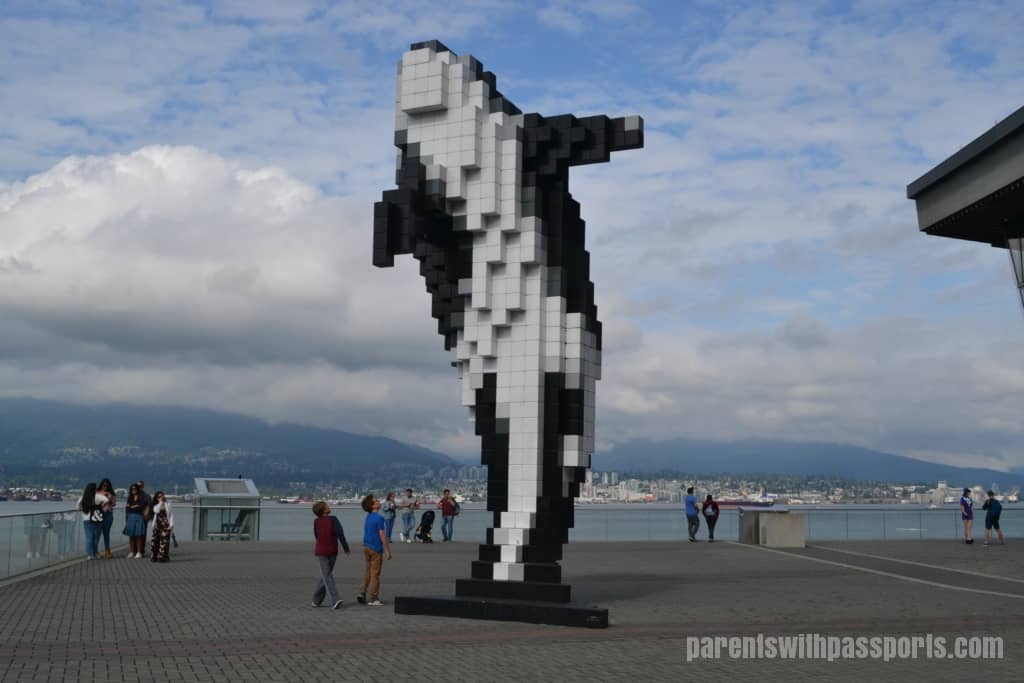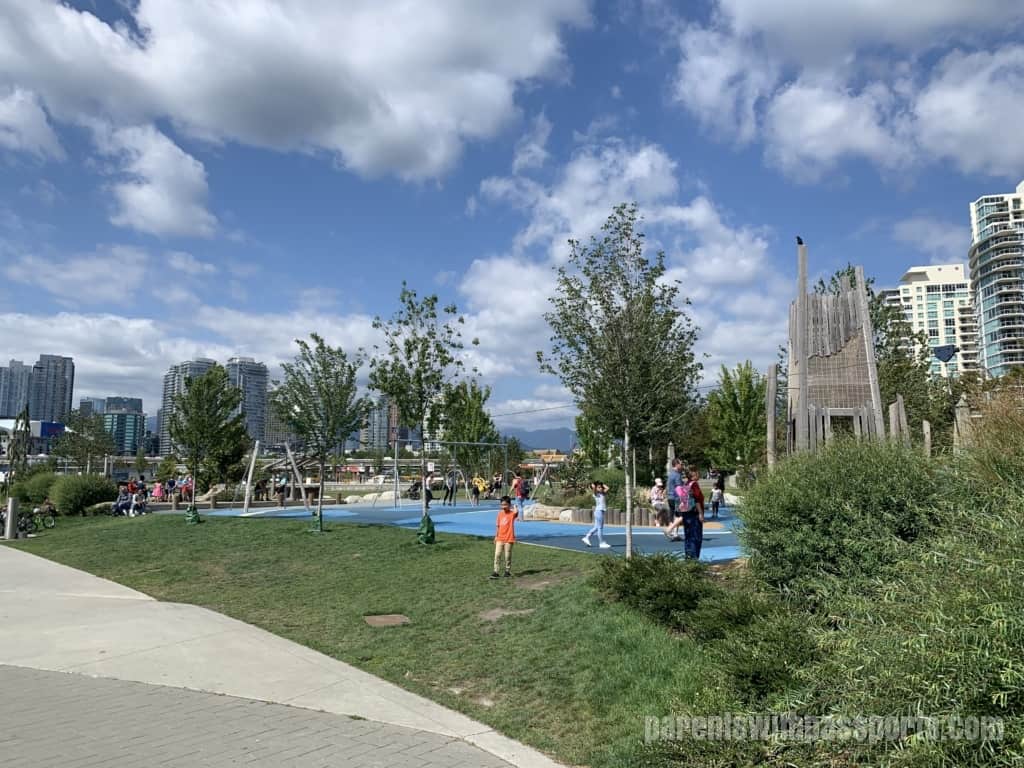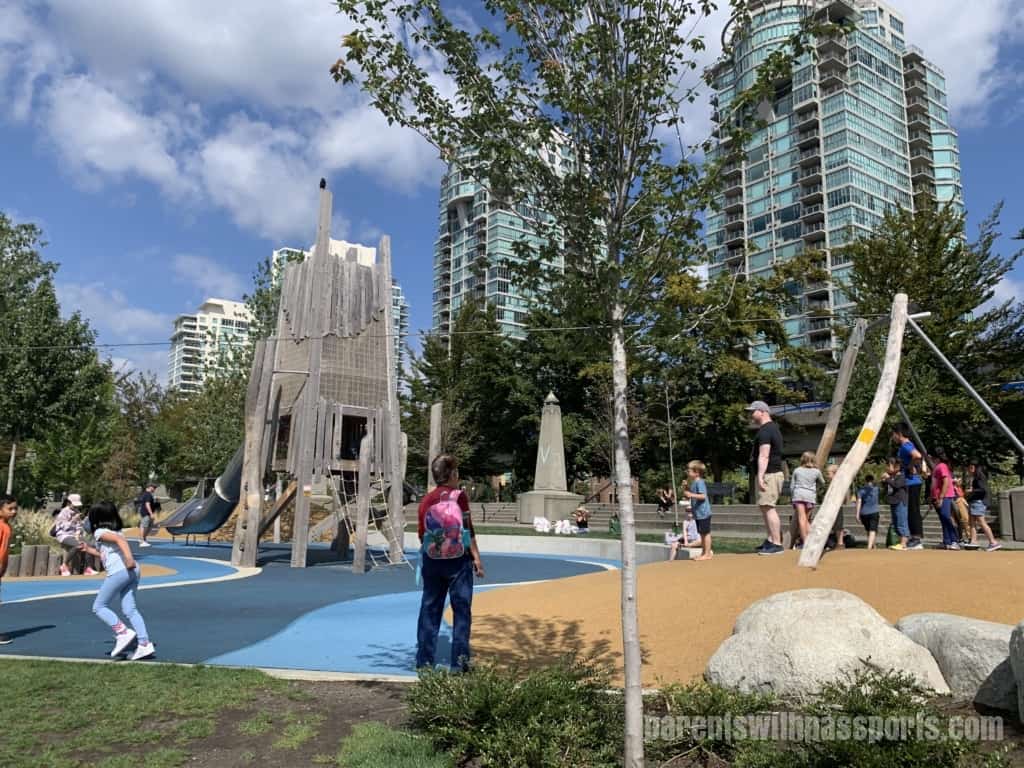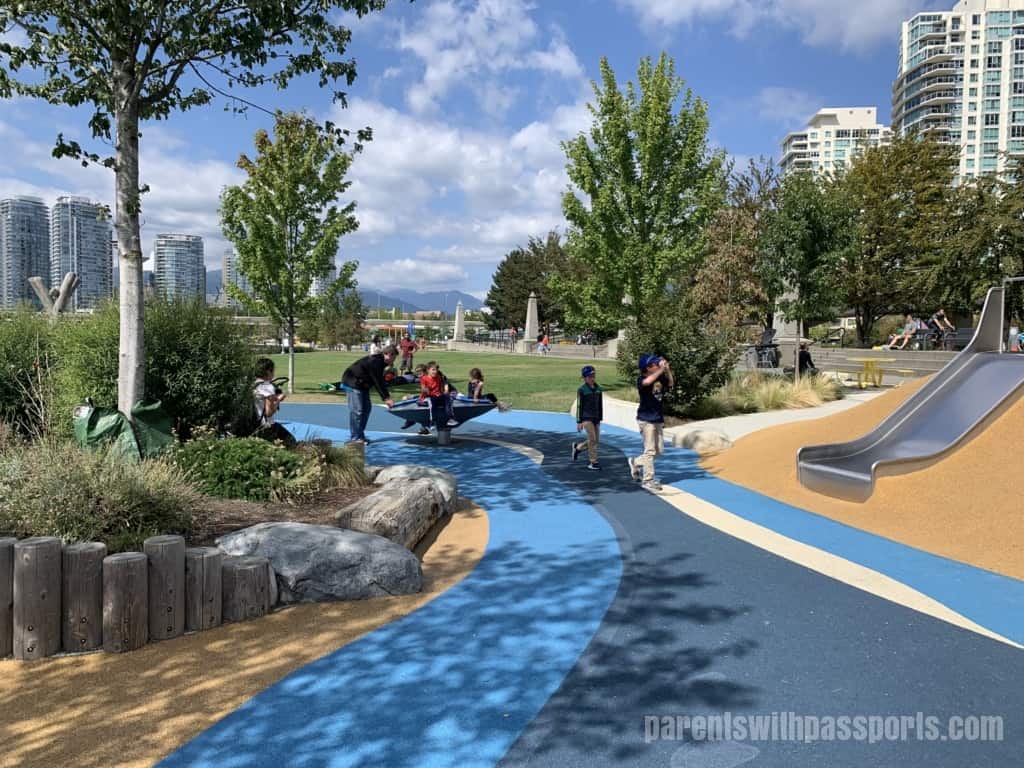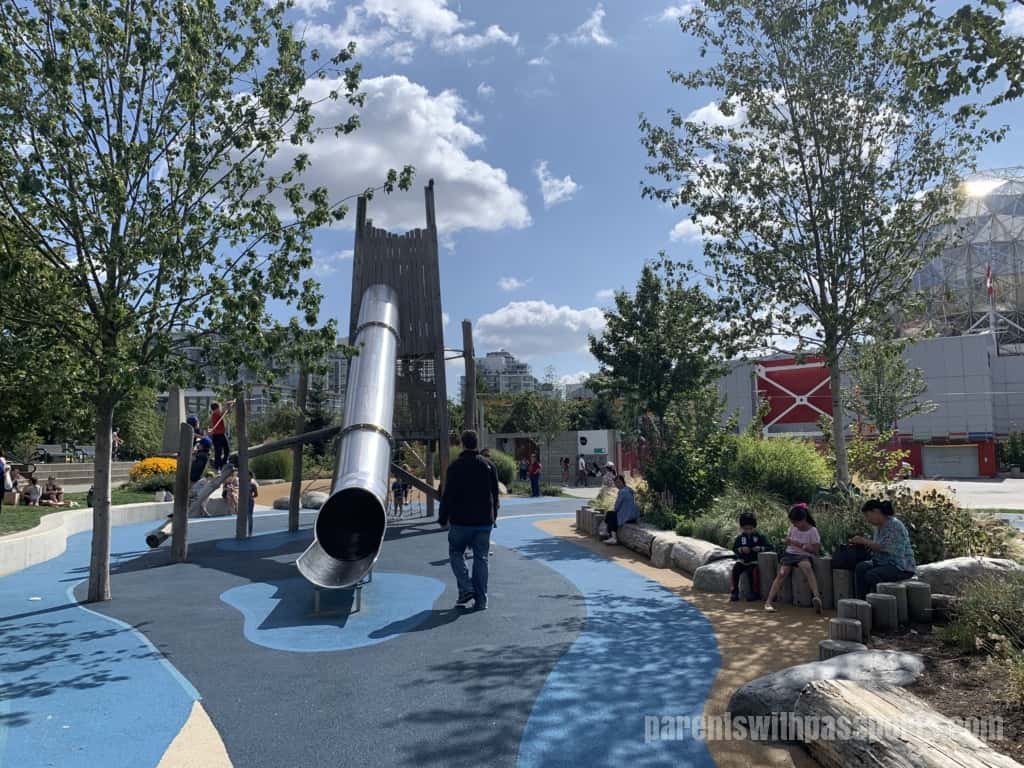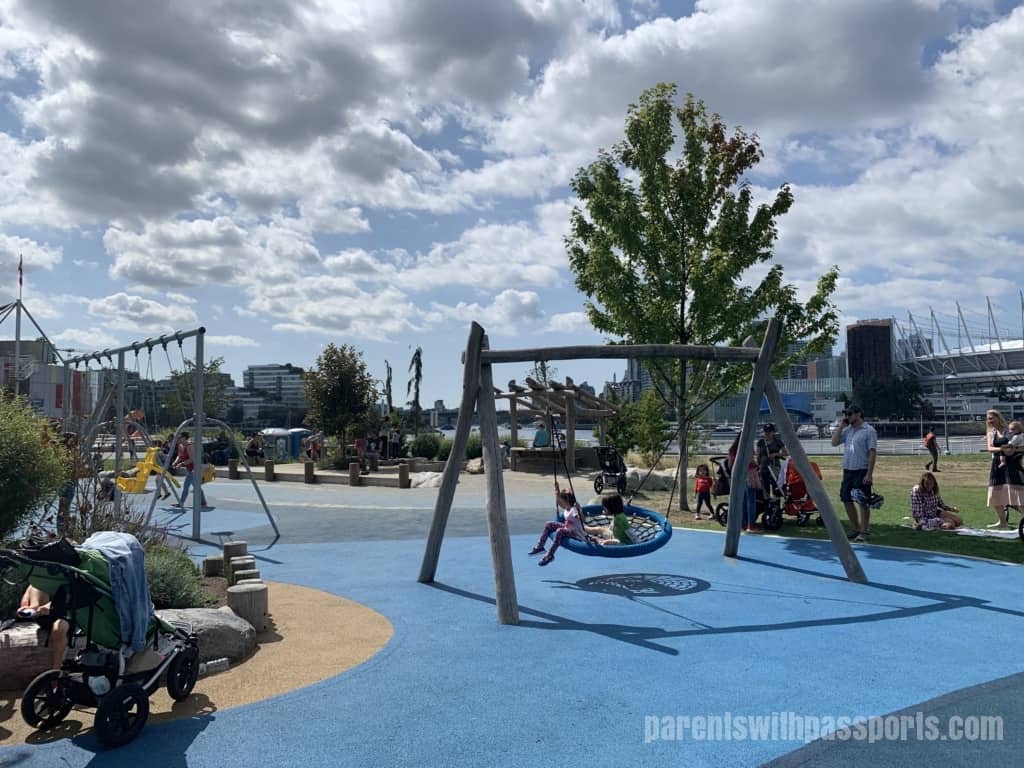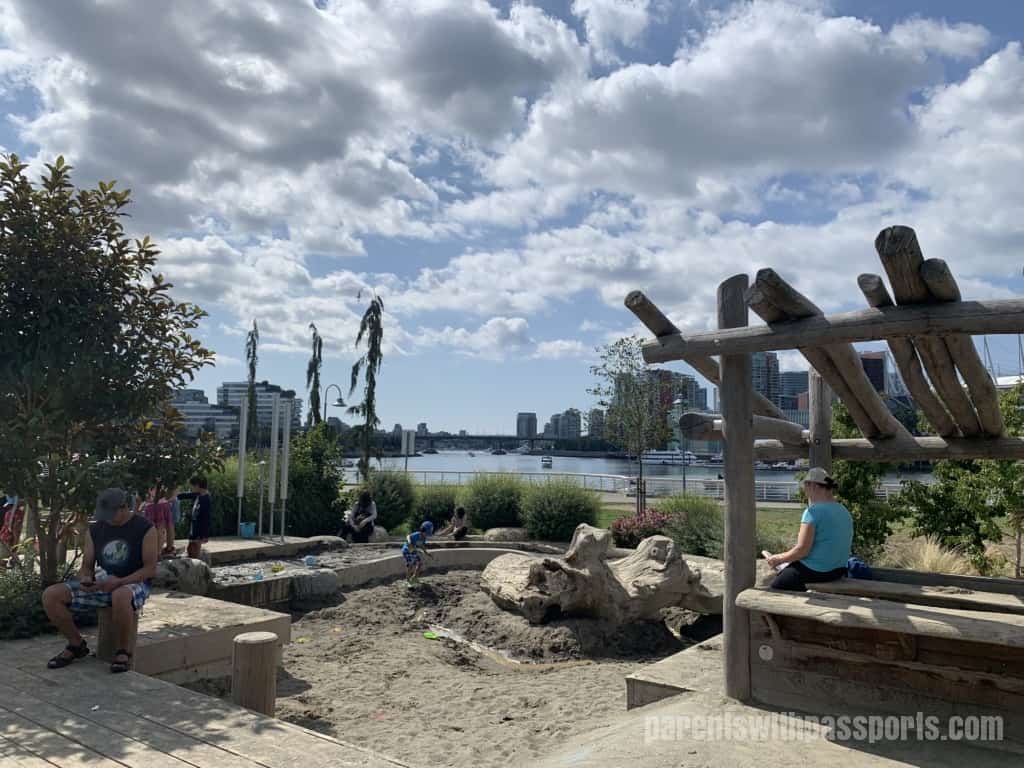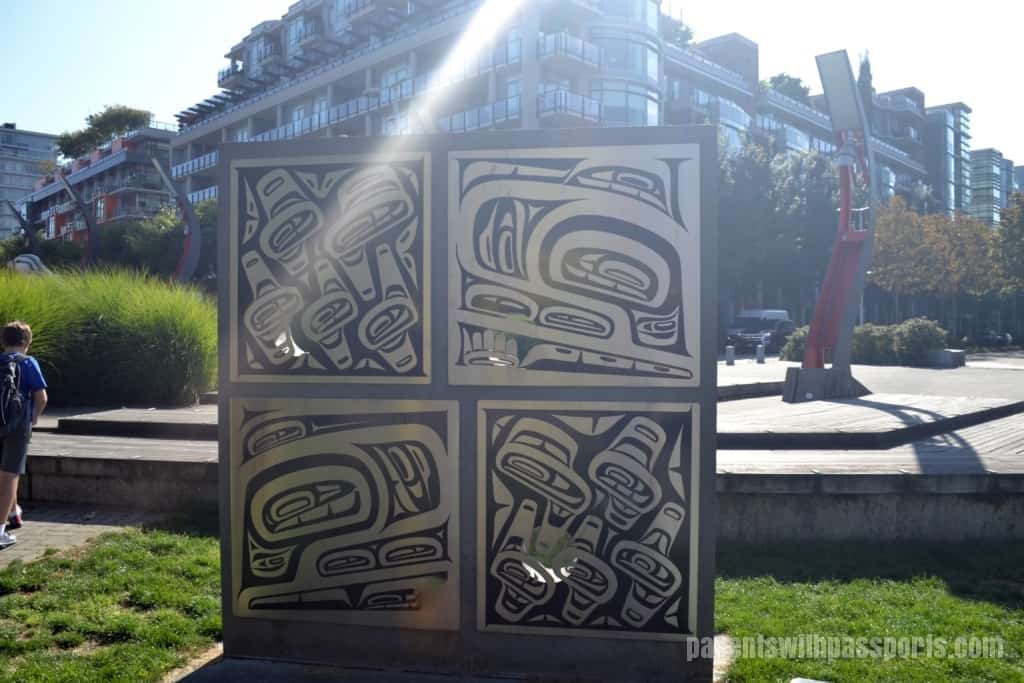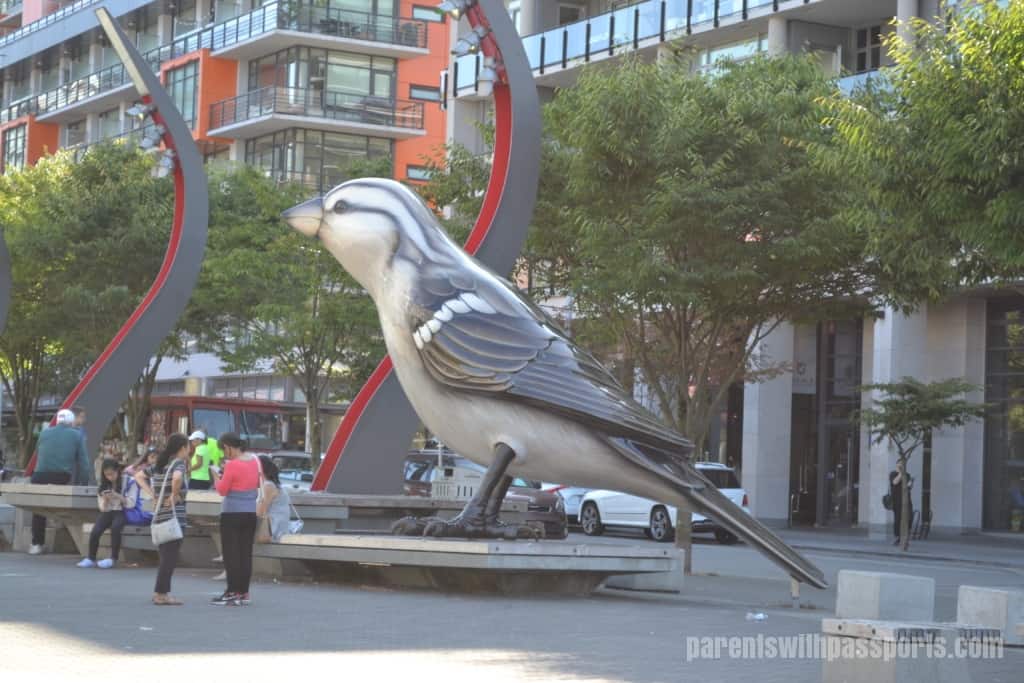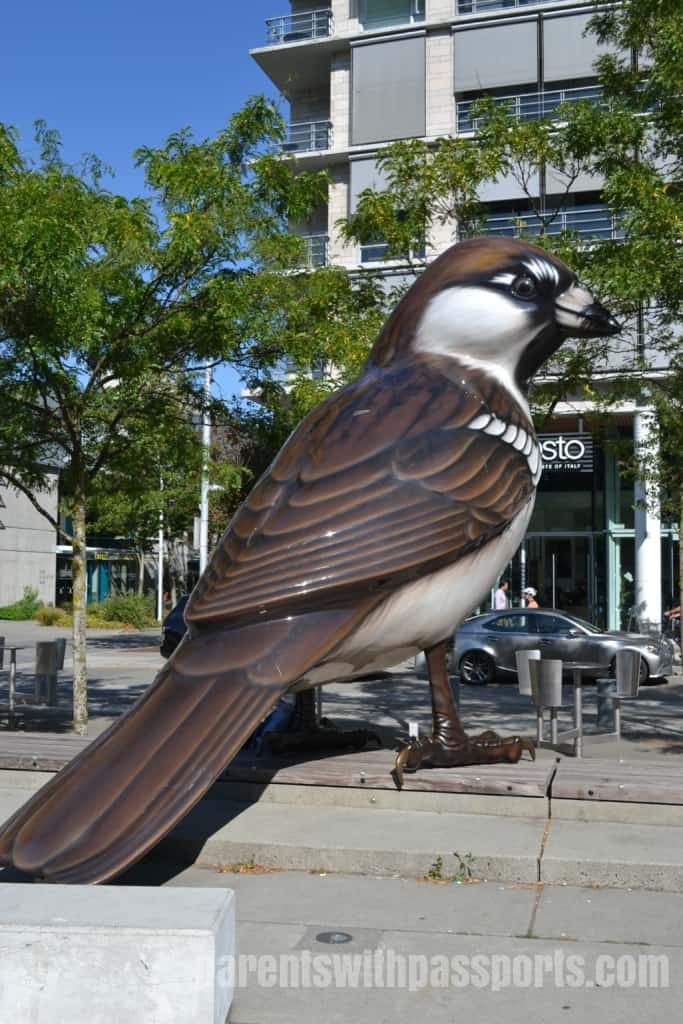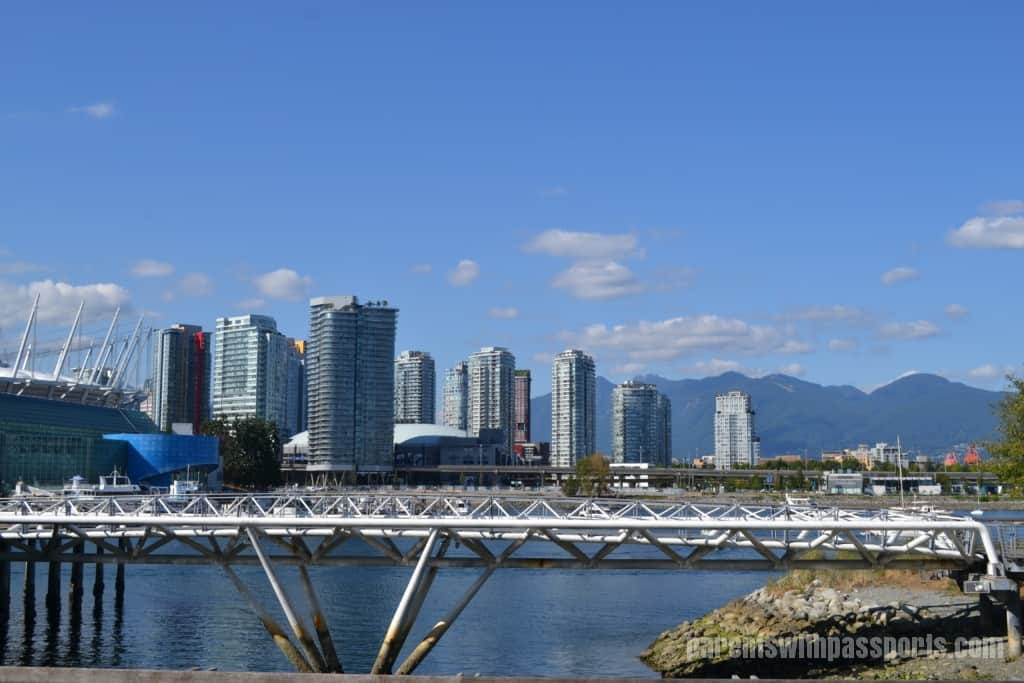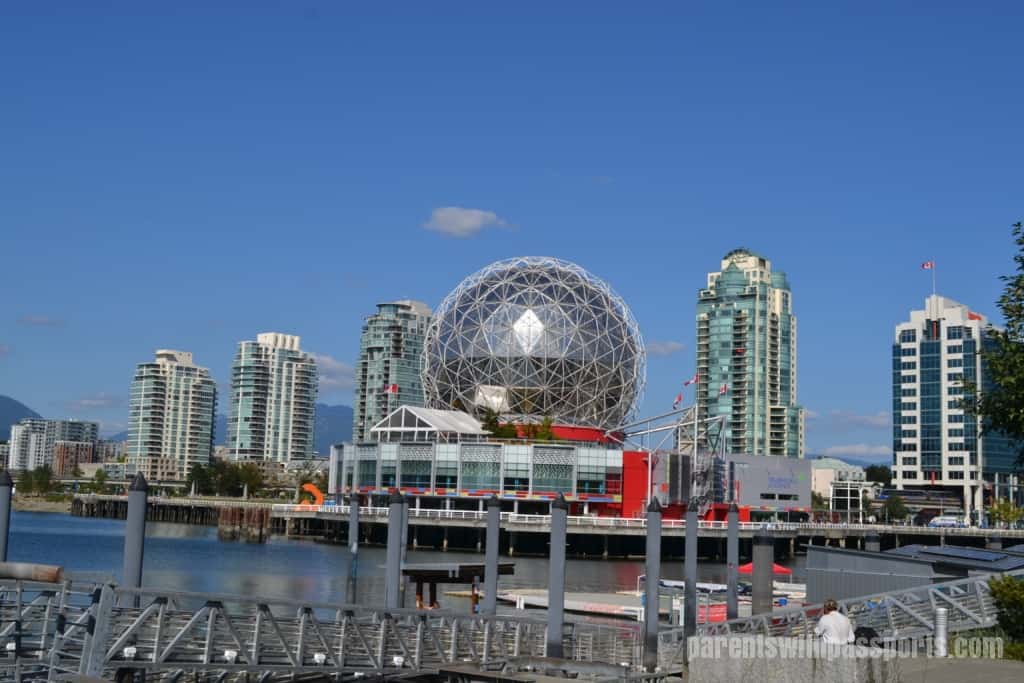In addition to our scheduled outings in Vancouver, we had some time to just wander around the city. Vancouver is a big city with lots to see, so we just focused on the highlights that fit in logistically with our other plans. We missed some big ones like the Chinatown and Granville Island but got a good taste of the city.
Vancouver Airport
This seems like a silly one but if you are arriving in Vancouver via airplane, the airport has some incredible works of art to check out. We came in late at night but the kids still wanted to take the time to stop and look at the displays. The art offers a really great introduction to the city, as it highlights the culture and natural attractions of the area.
To get from our arrival gate to baggage claim, we walked through an art installation called The Pacific Passage. An elevated walking area took us through an amazing display representing coastal British Columbia. A combination of indigenous artwork, live trees, and audio sounds of the coast piped in over speakers made you immediately feel immersed in the culture and natural environment of BC. It was truly stunning and such an unexpected surprise on our arrival.
The centerpiece of the display is the giant thunderbird hanging from the ceiling. Known as the keeper of the sky, this mythological bird displays power and strength. Made of aluminum and birch, the figure entitled Hetux represents and is named after artist Connie Watt’s grandmother. It is such an incredible greeting for weary travelers and a unique introduction to the city.
We passed two other impressive works of art in the international terminal. At the top of the escalator leading down to customs, a large disc carving is displayed on the wall. Known as Flight (Spindle Whorl), this wood carving is mounted in front of a stone wall with water pouring down it. The water and stone represent the land, while the carvings on the spindle whorl represent flight.
At the bottom of the escalator stand two carved figures, known as the Musqueam Welcome Figures. These figures are a traditional Coast Salish welcome and are inspired by house posts of the First Nations tribe.
That was the end of the surprise art tour that greeted us on arrival at YVR, but the airport had one last treat in store for us. Before departing we saw The Spirit of Haida Gwaii: The Jade Canoe. This amazing sculpture is located outside security in the international terminal. In this masterpiece, a bronze canoe is filled with 13 passengers, including humans, animals, and creatures from Haida mythology. The green patina finish is representative of jade, British Columbia’s official gemstone. To learn more about this incredible work of art, read the airport’s blog 20 Facts About the Jade Canoe.
It was such an unexpected treat to find so many incredible works of art in the Vancouver Airport. Definitely seek out these and the many other pieces on display while you are waiting for your flight.
Canada Place
Moving from air to water transportation, Vancouver’s port, Canada Place, is a great place to explore as well. Built to look like a huge sailing vessel, the building itself includes a cruise ship terminal, a convention center, an office tower, a hotel, and a virtual flight ride (FlyOver Canada). We stayed in the Pan Pacific, the hotel that sits atop Canada Place, and enjoyed exploring the area.
The Canadian Trail is the loop around Canada Place. It is a virtual walk across the country, with 13 sections representing the ten provinces and three territories of Canada.
The building is impressive in both its design and its multi-purpose function. The sails are what make this an iconic Vancouver landmark. The five white sails are 90 feet tall and made of Teflon coated fiberglass.
The sails of Canada Place are visible from all over the city, from Stanley Park to Granville Island to office towers across downtown. My parents’ hotel room had a fantastic view from above the sails. And we were partial to the views with the Disney Wonder parked in front… or even better the view as we pulled away on the Wonder!
Whether you are heading on a cruise or not, Canada Place is a neat place to walk around and is really central to a lot of the city sights. Also, lots of tours depart from the area and you can catch free shuttles to Grouse Mountain and Capilano Suspension Bridge from here.
Coal Harbour
In Stanley Park, we walked a section of the seawall around Brockton Point and back towards the city. We continued our walk all the way back to Canada Place, passing through Devonian Harbour Park and Coal Harbour. The transition from the Stanley Park seawall to the Coal Harbour seawall is seamless.
Along the path we walked around a corner and came upon a silver building sitting atop slightly askew stilts. I have to admit we were all stumped by its appearance along the path. There is no sign or explanation of the building, and as a roughly half size scale model of a house, it seemed made for kids to play in, were it not up on stilts. It turned out to be a sculpture by artist Liz Magor. A replica of the old boat sheds in this area, the work is an optical illusion of sorts. It was definitely a conversation point among our group.
Continuing our walk we passed the dock where the sea planes left from. The kids enjoyed watching them take off from the water.
From there we headed up a huge set of steps and came to Jack Poole Plaza, home of the 2010 Winter Olympic Cauldron. The flame is only lit for special occasions but it is a cool landmark to visit. At almost 40 feet tall, it is still a striking display as it stands against its beautiful mountain and harbor backdrop.
Just beyond the cauldron is another famous Vancouver sculpture – the Digital Orca. This pixellated killer whale appears to be jumping right out of the sidewalk. Resembling a gigantic lego set, the kids all really loved this and spent a good amount of time running around it and enjoying its lumbering presence.
This basically brought us back to our hotel in Canada Place and ended our lengthy walk from the aquarium in Stanley Park. After starting off the morning with pouring rain, it was nice to see some blue sky starting to peek through. In the Pacific Northwest, chances are high you’ll have some rainy and/or cloudy days so just be prepared to do some (or all) of your Vancouver exploring in less than ideal weather.
Gastown
We went to dinner one night at the Old Spaghetti Factory in Gastown. The restaurant was great for a large group (13 people) and was very family friendly. We walked there from Canada Place and got to explore some of Gastown along the way.
Gastown is Vancouver’s oldest neighborhood. Located close to the sawmill, seaport, and railroad in the mid 1800s, Gastown was an industrial hub that attracted a rowdy crowd. In 1867, John “Gassy Jack” Deighton started a tavern in the neighborhood and the bustling area soon took off.
Today Gastown is known for its fashion and its food. It has the city’s hottest restaurants and its trendiest clothing stores. Yet despite its modern popularity, it has retained its historic charm. Historic building dot its cobblestone streets. But one of its most famous attractions – the Steam Clock – is designed to look like a 19th century antique, yet it was actually built in 1977.
After Gastown fell into disrepair in the 1960s, government funding helped spark the area’s revitalization in the 1970s. In hopes of drawing more visitors to the area, local store owners jointly funded the building of a steam clock. (It is also believed that the clock served the dual purpose of keeping homeless people from sleeping on the steam grate that it covered up.) The clock paid homage to the area’s industrial past as it ushered in its revitalized future.
The clock was originally powered by a steam engine but today runs on its backup electric motor due to its inability to keep accurate time under steam power. Every 15 minutes it plays the melody Westminster Quarters. On the hour, it plays the song and then whistles and shoots steam once for every hour.
I thought it was funny that so many people crowded on the street corner, anxiously waiting for the clock to strike the top of the hour. It ended up being cool though and worth waiting the 15 minutes (or less) if you are in the area. My oldest especially loved it because you could see the inner workings of the clock, which was pretty awesome.
Creekside Park
On debarkation day from our cruise, we ended up spending the day at the World of Science. We left the museum for lunch and then let the kids burn off some steam at the park next door.
Creekside Park was great! Located on the False Creek waterfront, it had beautiful views and nice grassy areas. And the playground was fantastic. It had a bright blue and yellow rubberized surface and fun equipment that was in great condition. (The park recently underwent a major renovation and renewal and reopened in August 2017.) It even had a mini zip line! We had kids ages 4 to 11 and they all enjoyed it.
This location is sort of off the beaten tourist path so it probably only makes sense to go there if you are going to Science World. But if that is on your agenda (and it should be!) then definitely stop by.
Olympic Village
After our day at Science World and Creekside Park, we decided to walk through Olympic Village on our way to the train stop. (There is a train stop right down the street from Science World but we wanted to explore a little so we opted to walk to for a further station that was on the direct line to our hotel.) The community housed athletes and officials during the 2010 winter Olympics. Featuring green roofs and solar heating, the village is one of the greenest communities of the world.
Today it is a mixed-use community that on the surface looks no different than any other joint residential and retail development. But walking around, its Olympic history can be seen in a variety of art installations and signage in the area.
The Olympic Truce Installation features two pieces of aboriginal art – one featuring an orca whale and the other featuring a raven. The piece is meant to signify the peace that takes place during the Olympics. Dating back to the 9th century, a truce in war and conflict was called to allow Olympic athletes to participate in the games. Beginning in Athens in 2004, Olympic host cities have built a “truce wall” as a symbol of this peace.
Nearby, the Southeast False Creek Olympic Plaza features a pair of sculptures known as The Birds. Two sparrows standing between 15 and 18 feet tall loom over the plaza. Interestingly, the artist was inspired by Alfred Hitchcock’s horror movie of the same name. Themes of immigration also pervade this work, as sparrows are a non-native species that are now commonplace. The boys enjoyed walking next to the statues – there was something oddly creepy yet fascinating about the humongous birds towering over the people below.
Other than the works associated with the Olympic and Paralympic Public Art Program, this area has little remaining connection to the Olympics. It does have spectacular views though. With the mountains as a backdrop, the views of the city were incredible.
Vancouver is the type of city where you will stumble across something interesting and notable almost anywhere you go. Almost all of the things written about above were not things we had specifically sought out but simply things we had stumbled across in our journeys. I recommend reading up some on the areas you are going to visit; I found out after the fact that we were close to several things we would have liked to have seen had we known they were nearby. But whether you have a list of must-see sites, have loosely map things out, or simply want to go with the flow, you are bound to see a lot of amazing things in Vancouver.
